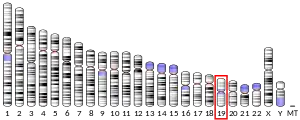LRG1
Leucine-rich alpha-2-glycoprotein 1 is a protein which in humans is encoded by the gene LRG1.[5]
| LRG1 | |||||||||||||||||||||||||||||||||||||||||||||||||||
|---|---|---|---|---|---|---|---|---|---|---|---|---|---|---|---|---|---|---|---|---|---|---|---|---|---|---|---|---|---|---|---|---|---|---|---|---|---|---|---|---|---|---|---|---|---|---|---|---|---|---|---|
| Identifiers | |||||||||||||||||||||||||||||||||||||||||||||||||||
| Aliases | LRG1, HMFT1766, LRG, leucine-rich alpha-2-glycoprotein 1, leucine rich alpha-2-glycoprotein 1 | ||||||||||||||||||||||||||||||||||||||||||||||||||
| External IDs | OMIM: 611289 MGI: 1924155 HomoloGene: 36468 GeneCards: LRG1 | ||||||||||||||||||||||||||||||||||||||||||||||||||
| |||||||||||||||||||||||||||||||||||||||||||||||||||
| |||||||||||||||||||||||||||||||||||||||||||||||||||
| |||||||||||||||||||||||||||||||||||||||||||||||||||
| |||||||||||||||||||||||||||||||||||||||||||||||||||
| |||||||||||||||||||||||||||||||||||||||||||||||||||
| Wikidata | |||||||||||||||||||||||||||||||||||||||||||||||||||
| |||||||||||||||||||||||||||||||||||||||||||||||||||
Function
The leucine-rich repeat (LRR) family of proteins, including LRG1, have been shown to be involved in protein-protein interaction, signal transduction, and cell adhesion and development. LRG1 is expressed during granulocyte differentiation.[5][6]
LRG1 has been shown to be involved in promoting neovascularization (new blood vessel growth) through causing a switch in transforming growth factor beta (TGFbeta) signaling in endothelial cells. LRG1 binds to the accessory receptor endoglin and promotes signaling via the ALK1-Smad1/5/8 pathway.[7]
Application
Levels of the LRG protein are markedly elevated in acute appendicitis and therefore could be used as a diagnostic aid.[8]
LRG1 may be a potential therapeutic target for the treatment of diseases where there is aberrant neovascularization.[7]
Circulating LRG1 levels are increased in many cancer patients and may be a useful biomarker. Inhibition of LRG1 normalises the tumor vasculature, improves the efficacy of cytotoxic and immune therapies,[9] and restricts metastatic spread. [10]
LRG1 has been implicated in the pathogenesis of numerous diseases including cancer, eye disease, neurodegenerative disease, diabetes, lung and kidney disease[11]
References
- GRCh38: Ensembl release 89: ENSG00000171236 - Ensembl, May 2017
- GRCm38: Ensembl release 89: ENSMUSG00000037095 - Ensembl, May 2017
- "Human PubMed Reference:". National Center for Biotechnology Information, U.S. National Library of Medicine.
- "Mouse PubMed Reference:". National Center for Biotechnology Information, U.S. National Library of Medicine.
- "Entrez Gene: LRG1 leucine-rich alpha-2-glycoprotein 1".
- O'Donnell LC, Druhan LJ, Avalos BR (September 2002). "Molecular characterization and expression analysis of leucine-rich alpha2-glycoprotein, a novel marker of granulocytic differentiation". Journal of Leukocyte Biology. 72 (3): 478–485. doi:10.1189/jlb.72.3.478. PMID 12223515. S2CID 967662.
- Wang X, Abraham S, McKenzie JA, Jeffs N, Swire M, Tripathi VB, et al. (July 2013). "LRG1 promotes angiogenesis by modulating endothelial TGF-β signalling". Nature. 499 (7458): 306–311. Bibcode:2013Natur.499..306W. doi:10.1038/nature12345. PMC 3836402. PMID 23868260.
- Vargas IM (2009-06-23). "A urine test for appendicitis?". HarvardScience Press Release. Harvard College. Retrieved 2009-06-25.
- O'Connor MN, Kallenberg DM, Camilli C, Pilotti C, Dritsoula A, Jackstadt R, et al. (November 2021). "LRG1 destabilizes tumor vessels and restricts immunotherapeutic potency". Med. 2 (11): 1231–1252.e10. doi:10.1016/j.medj.2021.10.002. PMID 35590198.
- Singhal M, Gengenbacher N, Abdul Pari AA, Kamiyama M, Hai L, Kuhn BJ, et al. (September 2021). "Temporal multi-omics identifies LRG1 as a vascular niche instructor of metastasis". Science Translational Medicine. 13 (609): eabe6805. doi:10.1126/scitranslmed.abe6805. PMC 7614902. PMID 34516824. S2CID 237402143.
- Camilli C, Hoeh AE, De Rossi G, Moss SE, Greenwood J (January 2022). "LRG1: an emerging player in disease pathogenesis". Journal of Biomedical Science. 29 (1): 6. doi:10.1186/s12929-022-00790-6. PMC 8781713. PMID 35062948.
Further reading
- Li X, Miyajima M, Jiang C, Arai H (February 2007). "Expression of TGF-betas and TGF-beta type II receptor in cerebrospinal fluid of patients with idiopathic normal pressure hydrocephalus". Neuroscience Letters. 413 (2): 141–144. doi:10.1016/j.neulet.2006.11.039. PMID 17194537. S2CID 54324280.
- Ramachandran P, Boontheung P, Xie Y, Sondej M, Wong DT, Loo JA (June 2006). "Identification of N-linked glycoproteins in human saliva by glycoprotein capture and mass spectrometry". Journal of Proteome Research. 5 (6): 1493–1503. doi:10.1021/pr050492k. PMID 16740002.
- Cummings C, Walder J, Treeful A, Jemmerson R (July 2006). "Serum leucine-rich alpha-2-glycoprotein-1 binds cytochrome c and inhibits antibody detection of this apoptotic marker in enzyme-linked immunosorbent assay". Apoptosis. 11 (7): 1121–1129. doi:10.1007/s10495-006-8159-3. PMID 16699948. S2CID 39838086.
- Liu T, Qian WJ, Gritsenko MA, Camp DG, Monroe ME, Moore RJ, Smith RD (2006). "Human plasma N-glycoproteome analysis by immunoaffinity subtraction, hydrazide chemistry, and mass spectrometry". Journal of Proteome Research. 4 (6): 2070–2080. doi:10.1021/pr0502065. PMC 1850943. PMID 16335952.
- Yamada S, Ohira M, Horie H, Ando K, Takayasu H, Suzuki Y, et al. (August 2004). "Expression profiling and differential screening between hepatoblastomas and the corresponding normal livers: identification of high expression of the PLK1 oncogene as a poor-prognostic indicator of hepatoblastomas". Oncogene. 23 (35): 5901–5911. doi:10.1038/sj.onc.1207782. PMID 15221005.
- Bunkenborg J, Pilch BJ, Podtelejnikov AV, Wiśniewski JR (February 2004). "Screening for N-glycosylated proteins by liquid chromatography mass spectrometry". Proteomics. 4 (2): 454–465. doi:10.1002/pmic.200300556. PMID 14760718. S2CID 29261009.
- Anderson NL, Polanski M, Pieper R, Gatlin T, Tirumalai RS, Conrads TP, et al. (April 2004). "The human plasma proteome: a nonredundant list developed by combination of four separate sources". Molecular & Cellular Proteomics. 3 (4): 311–326. doi:10.1074/mcp.M300127-MCP200. PMID 14718574.
- O'Donnell LC, Druhan LJ, Avalos BR (September 2002). "Molecular characterization and expression analysis of leucine-rich alpha2-glycoprotein, a novel marker of granulocytic differentiation". Journal of Leukocyte Biology. 72 (3): 478–485. doi:10.1189/jlb.72.3.478. PMID 12223515. S2CID 967662.
- Saito K, Tanaka T, Kanda H, Ebisuno Y, Izawa D, Kawamoto S, et al. (February 2002). "Gene expression profiling of mucosal addressin cell adhesion molecule-1+ high endothelial venule cells (HEV) and identification of a leucine-rich HEV glycoprotein as a HEV marker". Journal of Immunology. 168 (3): 1050–1059. doi:10.4049/jimmunol.168.3.1050. PMID 11801638.
- Takahashi N, Takahashi Y, Putnam FW (April 1985). "Periodicity of leucine and tandem repetition of a 24-amino acid segment in the primary structure of leucine-rich alpha 2-glycoprotein of human serum". Proceedings of the National Academy of Sciences of the United States of America. 82 (7): 1906–1910. Bibcode:1985PNAS...82.1906T. doi:10.1073/pnas.82.7.1906. PMC 397442. PMID 3856868.
- Andersen JD, Boylan KL, Xue FS, Anderson LB, Witthuhn BA, Markowski TW, et al. (January 2010). "Identification of candidate biomarkers in ovarian cancer serum by depletion of highly abundant proteins and differential in-gel electrophoresis". Electrophoresis. 31 (4): 599–610. doi:10.1002/elps.200900441. PMC 3520508. PMID 20162585.
This article incorporates text from the United States National Library of Medicine, which is in the public domain.



